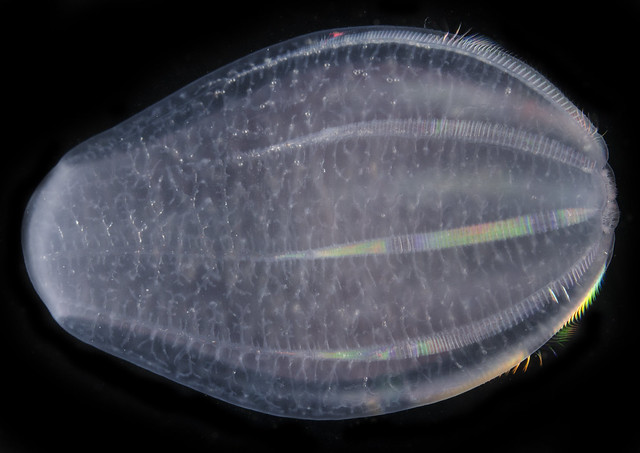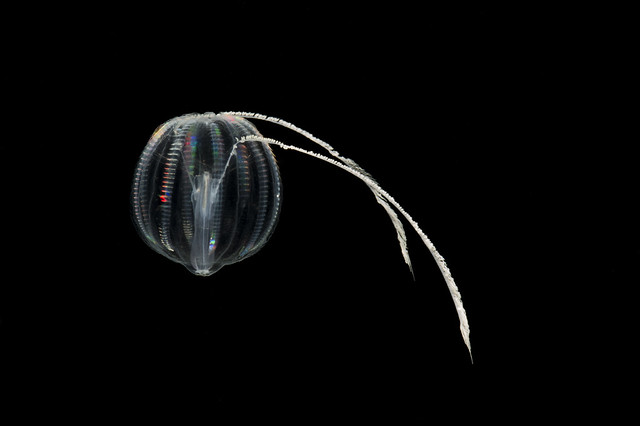Combing through history: Auburn University leads team of scientists who provide more proof that comb jellies are at the base of the animal kingdom
Article body
In 2014, Auburn University scientists in the Department of Biological Sciences’ Molette Biology Laboratory for Environmental and Climate Change Studies and University of Florida researchers shook the foundation of evolutionary biology.
For more than a century, researchers believed sponges were the earliest living lineages of the animal tree. Thanks to modern genomic sequencing techniques, Auburn scientists, together with scientists at the Universities of Florida and Alabama, provided novel evidence that ctenophores, or comb jellies, are actually at the base of the animal kingdom. The research results were published in the journal Nature, sparking a debate in the scientific community.
To further clarify and establish the new discovery, Auburn University’s Molette Biology Laboratory, directed by Biological Sciences Professor Kenneth Halanych, led a team of scientists from Auburn and the Universities of Alabama and Florida in a project designed to better understand the evolutionary relationships between ctenophores, as well as reexamine the placement of ctenophores as the sister taxon, or group, to all other animals.
Ctenophores comprise approximately 200 described species with complicated and unresolved relationships among the various lineages. Additionally, ctenophores are a diverse group containing numerous physiological and ecological differences.
“We were surprised to discover just how different the early evolution of animals is compared to what has been traditionally assumed,” said Halanych. “We found interesting and major changes in lifestyle, including feeding habits and habitat preferences, with some animals being benthic and others pelagic.
“Understanding relationships within ctenophores, or comb jellies, is paramount to understanding some of the important features found in early animals, such as the evolution of the nervous system and muscles. Interestingly, the earliest branching ctenophore began developing muscles like those found in bilateral animals.”
Scientists from all three universities collected ctenophores from around the world and used modern genetic sequencing techniques to examine the genetic variation amongst ctenophores; further establish ctenophora as the sister group to all other animals; and refine the genetic relationships between species of ctenophores.
The team ultimately found that modern comb jellies diversified about 88 to 350 million years ago, much earlier than previously suspected.
Nathan Whelan, who is now the director of U.S. Fish and Wildlife Service’s Southeast Conservation Genetics Lab, is the lead scientist on the study and was a postdoctoral researcher in Auburn’s Mollett Lab at the time of the study. Whelan also holds a doctorate from the University of Alabama.
"Being a postdoctoral researcher at Auburn and in Ken Halanych’s lab gave me exceptional opportunities to pursue my research interests, including animal evolution, genomics and field biology,” said Whelan. “Our work for this project reveals important patterns about early animal evolution and begins to unravel mysteries surrounding the diversity of comb jellies. By adding new data and continuing to challenge conventional wisdom, we have obtained much stronger results than in the past."
Others working on the project include Kevin M. Kocot, a University of Alabama assistant professor of biological sciences and curator of Invertebrate Zoology in the Alabama Museum of Natural History. Kocot received his doctorate under the direction of Halanych at Auburn University, and for this project, he worked to provide bioinformatic and phylogenetic analyses and interpretations.
“The analysis supports the conclusion that comb jellies, not the simpler sponges, are the sister group to all other animals,” said Kocot. “Taken together, these results have important implications for our understanding of early animal evolution and provide insight into a poorly-known but fascinating group of marine invertebrates.”
Leonid Moroz, Distinguished Professor of Neuroscience, Genetics, Biology and Chemistry at the University of Florida, is a pioneer of comparative genomics and transcriptomics of ctenophores. Since 2007, he has collected the animals around the globe and sequenced them both on land and aboard oceanic research vessels. Thus, the team had access to unique genetic data from species covering the broadest diversity of forms and lifestyles within the enigmatic group.
“Comb jellies are extremely fragile marine organisms,” said Moroz. “Most of them can only be studied within their natural habitats. Thus, we must find them, perform experiments on a ship, make samples, and even sequence in open oceans, sometimes thousands of miles offshore. Every collection is an adventure by itself—from cold Antarctica to hot equatorial seas—to understand how Mother Nature made muscles and neurons in these creatures independently from the rest of animals. A fun job for a neuroscientist, and everyone, indeed!”
The results were recently published by Nature.com in a paper titled, “Ctenophore relationships and their placement as the sister group to all other animals” found online and to be featured in an upcoming edition of the journal Nature Ecology and Evolution. The work was supported by NASA, the National Science Foundation and the Ministry of Education of the Russian Federation.
Related Media
Related Links
- “Ctenophore relationships and their placement as the sister group to all other animals” paper in Nature Ecology and Evolution
- Auburn University Molette Biology Laboratory for Environmental and Climate Change Studies
- Lead scientist Nathan Whelan’s website
- University of Alabama Assiatant Professor Kevin Kocot’s website
- Distinguished Professor of Neuroscience, Genetics, Biology, and Chemistry at the University of Florida Leonid L Moroz’s website
- Director of the Molette Biology Laboratory for Environmental and Climate Change Studies and Biological Sciences Professor Kenneth Halanych’s website
- Auburn University College of Sciences and Mathematics
Media interested in this story can contact Communications Director Preston Sparks at (334) 844-9999 or preston.sparks@auburn.edu.
Auburn University is a nationally ranked land grant institution recognized for its commitment to world-class scholarship, interdisciplinary research with an elite, top-tier Carnegie R1 classification, life-changing outreach with Carnegie’s Community Engagement designation and an undergraduate education experience second to none. Auburn is home to more than 30,000 students, and its faculty and research partners collaborate to develop and deliver meaningful scholarship, science and technology-based advancements that meet pressing regional, national and global needs. Auburn’s commitment to active student engagement, professional success and public/private partnership drives a growing reputation for outreach and extension that delivers broad economic, health and societal impact.






